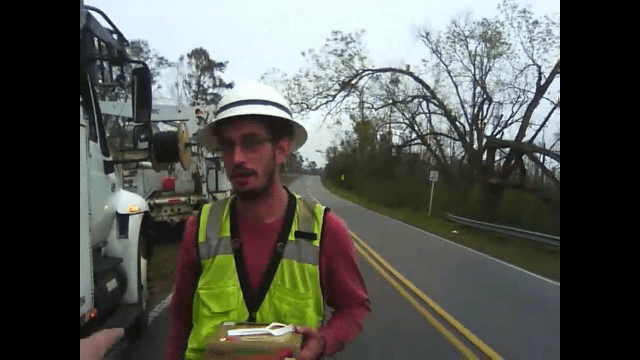Feeding Marianna and Panama City..
It’s been about a month since Hurricane Michael I told them I would Be back and I delivered on my Promise..
There was over 30 Line men still there restoring the power and I fed as many as I could..
Then I stumbled on a church with over 100 people living in tents in the parking lot and field.. I fed and gave them clothes and blankets..
There are many still living in tents around the city.. Many Businesses were lost. Some people were never found.. Homes are gone or are desperate need of repair.. Some people lost everything..
There is no Sunday Football for these people, there is no be up for work Monday morning when your job got swept away and leveled..
Hurricane Michael was the third-most intense Atlantic hurricane to make landfall in the contiguous United States in terms of pressure, behind the 1935 Labor Day hurricaneand Hurricane Camille of 1969. It was also the strongest storm in terms of maximum sustained wind speed to strike the contiguous United States since Andrew in 1992. In addition, it was the strongest storm on record in the Florida Panhandle, and was the fourth-strongest landfalling hurricane in the contiguous United States, in terms of wind speed.
The thirteenth named storm, seventh hurricane, and second major hurricane of the 2018 Atlantic hurricane season, Michael originated from a broad low-pressure area that formed in the southwestern Caribbean Sea on October 2. The disturbance became a tropical depression on October 7, after nearly a week of slow development. By the next day, Michael had intensified into a hurricane near the western tip of Cuba, as it moved northward. The hurricane strengthened rapidly in the Gulf of Mexico, reaching major hurricane status on October 9, peaking as a high-end Category 4 hurricane on the Saffir–Simpson scale. Approaching the Florida Panhandle, Michael attained peak winds of 155 mph (250 km/h) as it made landfall near Mexico Beach, Florida, on October 10, becoming the first to do so in the region as a Category 4 hurricane, and making landfall as the strongest storm of the season. As it moved inland, the storm weakened and began to take a northeastward trajectory toward Chesapeake Bay, weakening to a tropical storm over Georgia, and transitioning into an extratropical cyclone off the coast of the Mid-Atlantic states on October 12. Michael subsequently strengthened into a powerful extratropical cyclone and eventually impacted the Iberian Peninsula, before dissipating on October 16.

Your a great man Jersey
We are trying my friend .. And thank you very much for your support !
Thank You sir